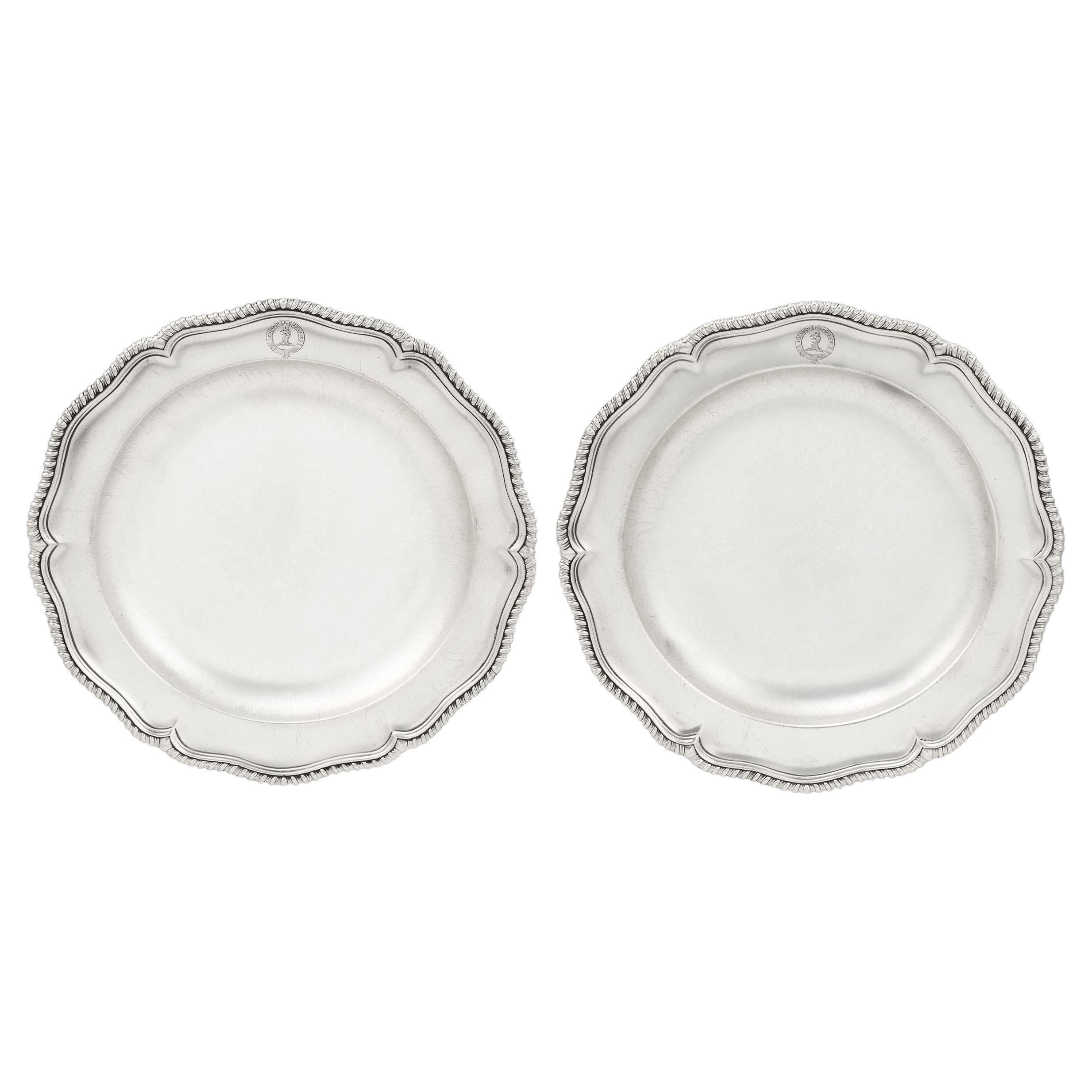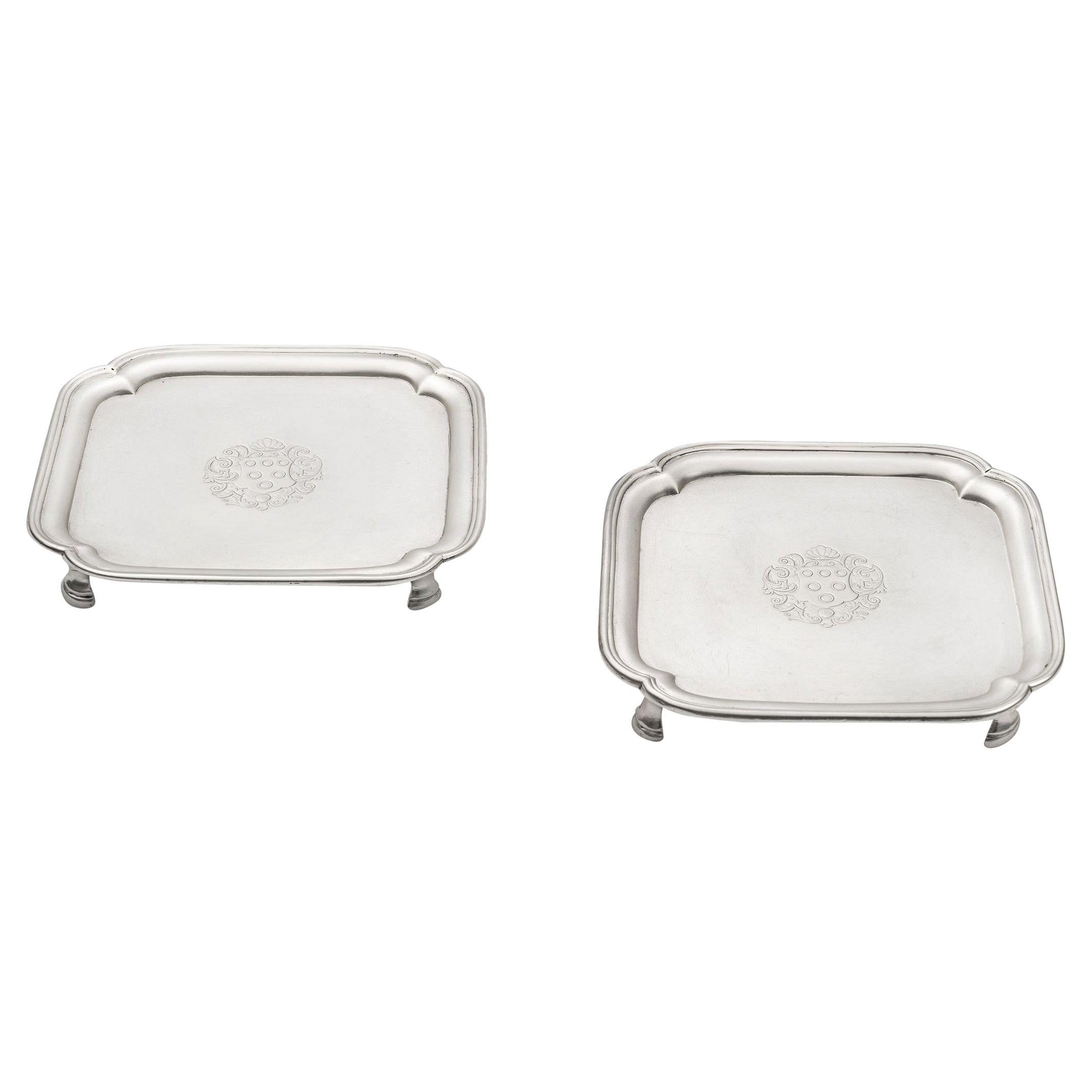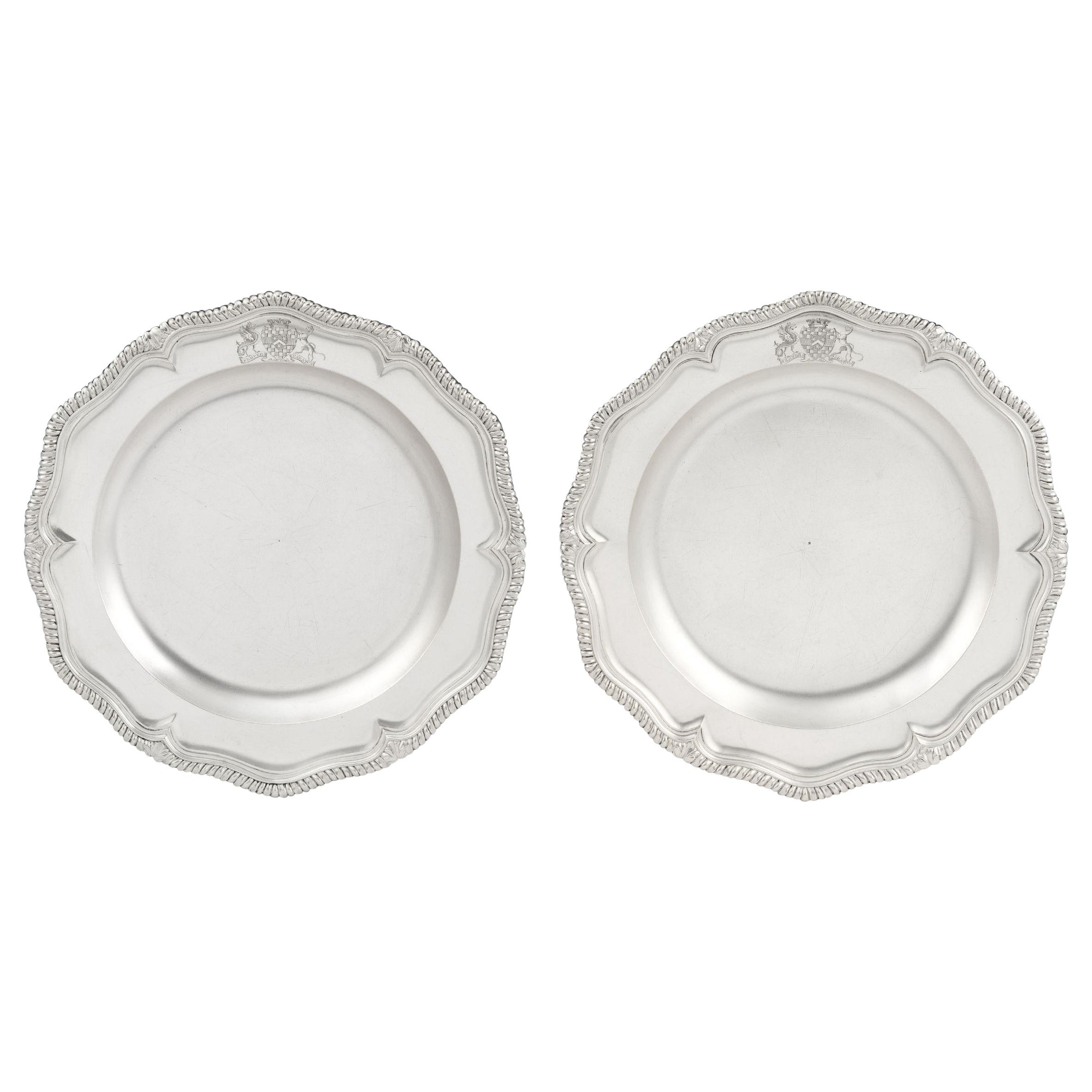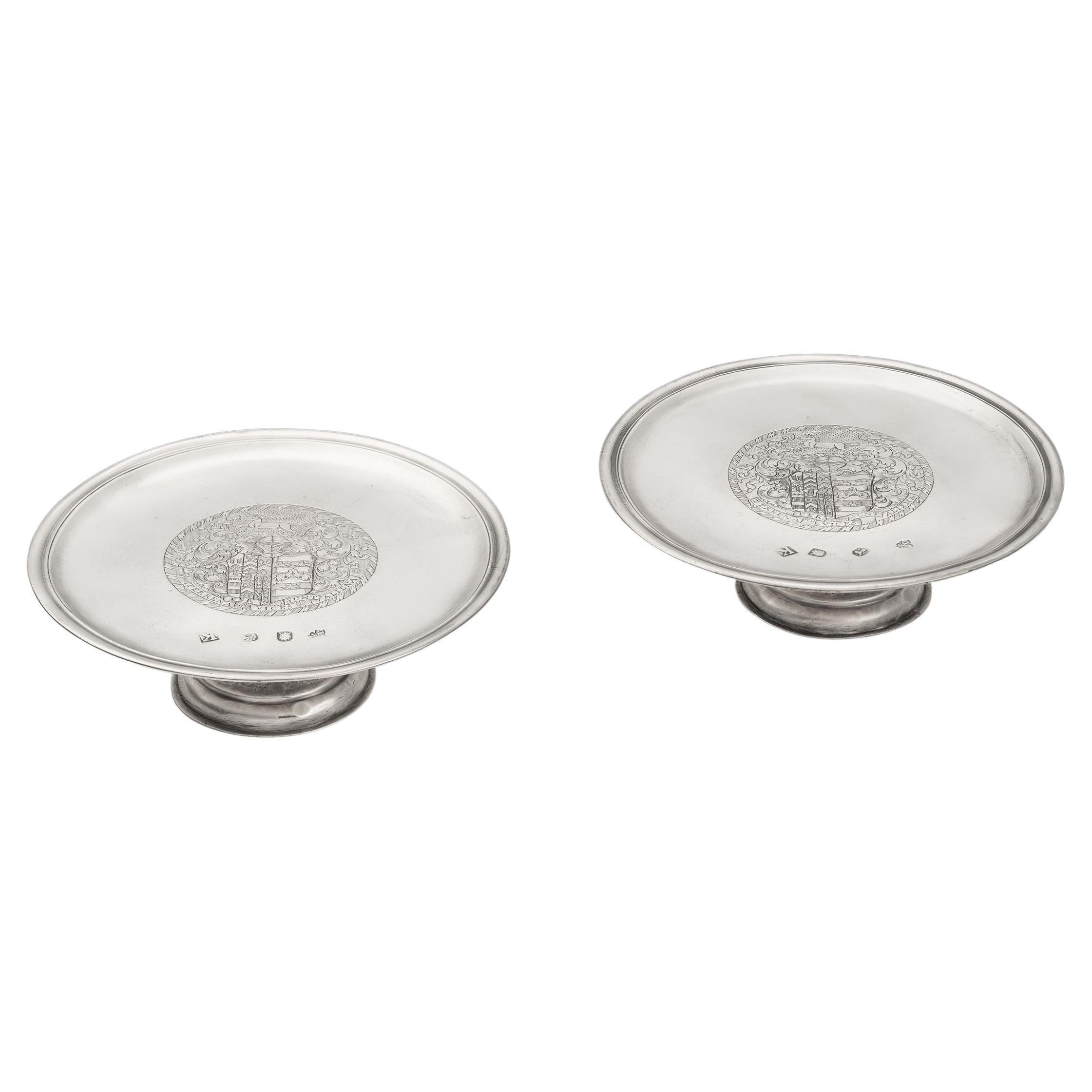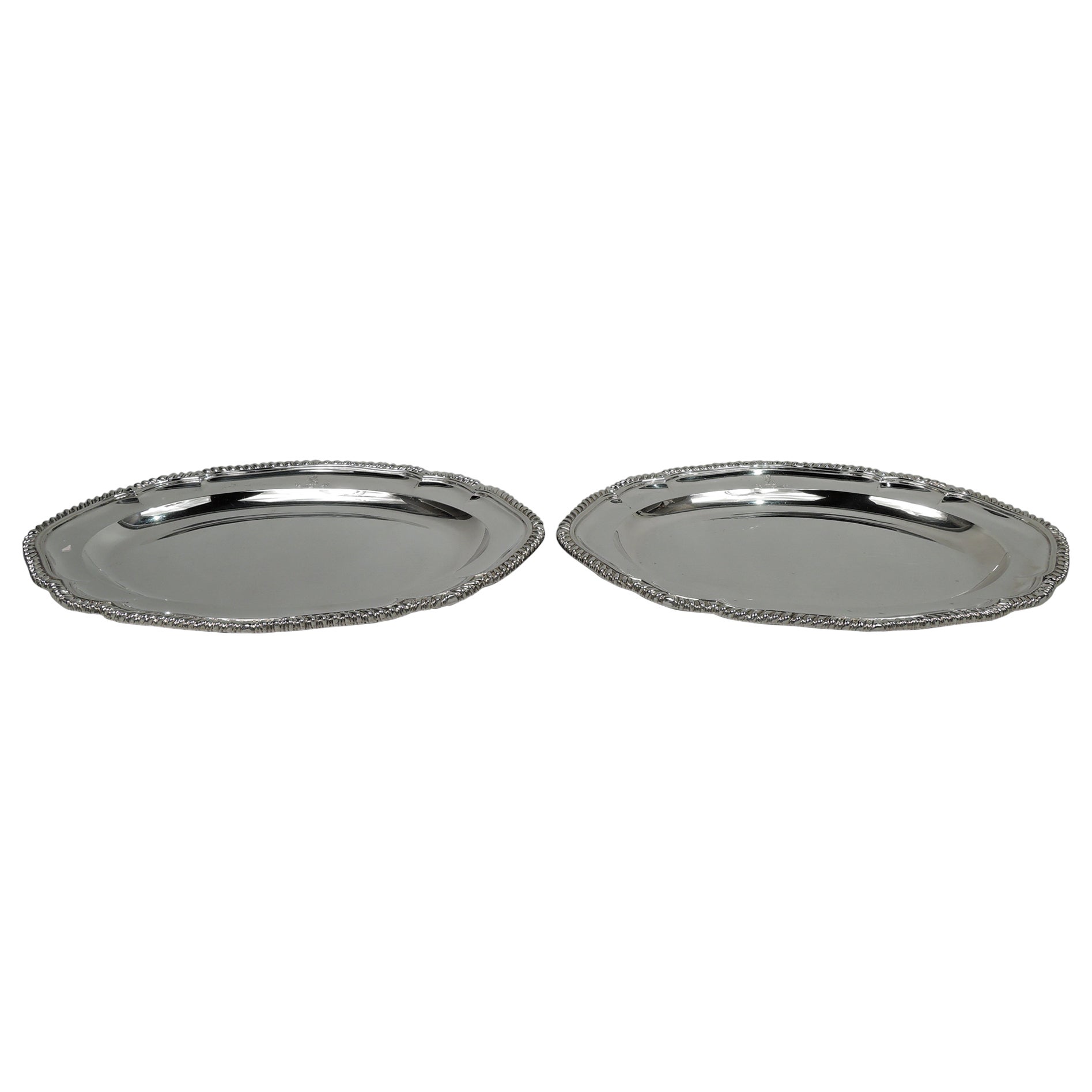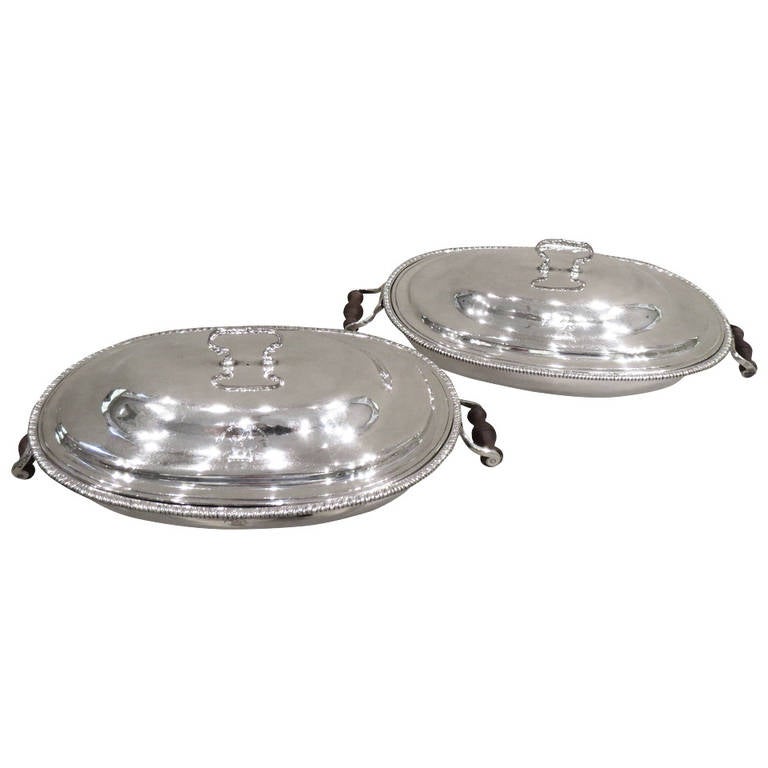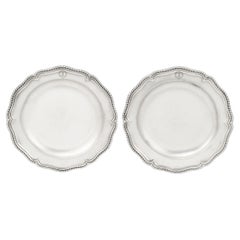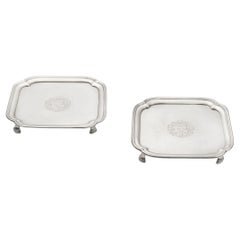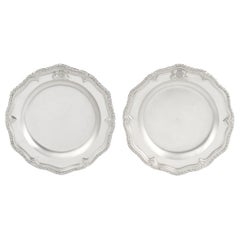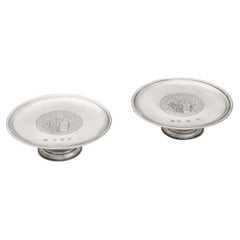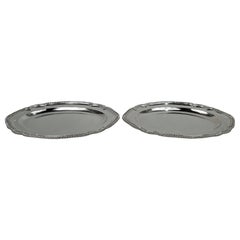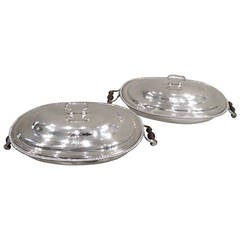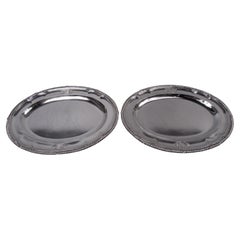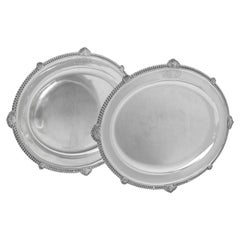Items Similar to Pair of George III Salvers/Stands Made in London in 1810 by William Frisbee
Want more images or videos?
Request additional images or videos from the seller
1 of 8
Pair of George III Salvers/Stands Made in London in 1810 by William Frisbee
$8,179.19per set
£5,950per set
€6,965.46per set
CA$11,423.47per set
A$12,389.02per set
CHF 6,507.18per set
MX$150,485.65per set
NOK 81,427.11per set
SEK 76,668.17per set
DKK 52,024.11per set
About the Item
The Salvers/Stands are of the finest quality and stand on four cast panel feet, with a scroll end and reeded edge. The main body is oval in form with a raised rim which is decorated with a contemporary shield shaped Armorial surrounded by a crisp cartouche of drapery mantling. The Salvers are of a very good weight and possess a good colour and crisp marks. The quality of the salvers is not surprising when the maker is considered. He worked in the circle of Paul Storr and was in partnership with him 1792-1798. The work of Frisbee is scarce, however is always of the finest quality. These are ideal as tureen stands and one is pictured with a tureen.
The Arms are those of the first Ormsby to reside in County Sligo, who died in 1662. The family were of Lincolnshire origin and settled in Sligo about 1640, becoming extensive landowners. The Arms are specifically those of Anthony Ormsby of Ballinamore House, County Mayo.
Measures: Length: 10 inches, 25cm.
Width: 7.45 inches, 18.63cm.
Height: 1.2 inches, 3 cm.
Weight: 36oz, the pair.
- Creator:William Frisbee 1 (Maker)
- Dimensions:Height: 1.2 in (3.05 cm)Width: 10 in (25.4 cm)Depth: 7.45 in (18.93 cm)
- Sold As:Set of 2
- Style:George III (Of the Period)
- Materials and Techniques:
- Place of Origin:
- Period:
- Date of Manufacture:1810
- Condition:Wear consistent with age and use.
- Seller Location:London, GB
- Reference Number:1stDibs: LU978123997352
About the Seller
5.0
Recognized Seller
These prestigious sellers are industry leaders and represent the highest echelon for item quality and design.
Established in 1967
1stDibs seller since 2013
27 sales on 1stDibs
- ShippingRetrieving quote...Shipping from: London, United Kingdom
- Return Policy
Authenticity Guarantee
In the unlikely event there’s an issue with an item’s authenticity, contact us within 1 year for a full refund. DetailsMoney-Back Guarantee
If your item is not as described, is damaged in transit, or does not arrive, contact us within 7 days for a full refund. Details24-Hour Cancellation
You have a 24-hour grace period in which to reconsider your purchase, with no questions asked.Vetted Professional Sellers
Our world-class sellers must adhere to strict standards for service and quality, maintaining the integrity of our listings.Price-Match Guarantee
If you find that a seller listed the same item for a lower price elsewhere, we’ll match it.Trusted Global Delivery
Our best-in-class carrier network provides specialized shipping options worldwide, including custom delivery.More From This Seller
View AllPair of George II Serving Dishes Made in London in 1759 by William Cripps
By William Cripps
Located in London, GB
These very fine dishes are of a good large Size and are circular in form with a wide rim decorated with a shaped gadrooned band. Both have a deep bowl so t...
Category
Antique 1750s British George II Platters and Serveware
Materials
Sterling Silver
Pair of George II Salvers Made in London by John Tuite, 1729
By John Tuite
Located in London, GB
A Very Fine Pair of George II Salvers Made in London in 1729 by John Tuite
The Salvers stand on four cast pilaster supports in each corner. The main...
Category
Antique 18th Century English George II Decorative Dishes and Vide-Poche
Materials
Silver
Pair of George II Serving Dishes Made in London by Edward Aldridge, 1745
By Edward Aldridge
Located in London, GB
A Very Fine Pair of George II Serving Dishes Made in London in 1745 by Edward Aldridge.
The Dishes are shaped circular in form, with a stepped gadrooned border, interspersed with foliate motifs. The reverse is engraved with their number in the set, in addition to their original scratch weight. Both are very well marked, also on the reverse. Each border is engraved with the Armorial, Coronet, Supporters and Motto "Semper Paratus...
Category
Antique 18th Century English George II Decorative Dishes and Vide-Poche
Materials
Silver, Sterling Silver
Pair of George I Tazzas Made in London in 1725 by William Darker
By William Darker
Located in London, GB
AN EXCEPTIONAL PAIR OF GEORGE I TAZZAS MADE IN LONDON IN 1725 BY WILLIAM DARKER
The Tazzas stand on a trumpet shaped spreading foot and the circular top has a slightly raised rim ...
Category
Antique 1720s English George I Sterling Silver
Materials
Sterling Silver
Pair of George II Waiters or Bottle Stands by James Warren, circa 1755
Located in London, GB
A Rare Pair of George II Waiters or Bottle Stands Made in Dublin circa 1755 by James Warren.
The Waiters are of an unusual size and stand on three ho...
Category
Antique 1750s English George II Tableware
Materials
Silver, Sterling Silver
Pair of George III Second Course Dishes made in London by William Stroud in 1802
Located in London, GB
The dishes are circular in form with a raised rim which is decorated with a plain gadrooned band. The border is engraved with a contemporary Armorial surrounded by a cartouche of dra...
Category
Antique Early 19th Century English George III More Dining and Entertaining
Materials
Silver
$8,179 / set
Free Shipping
You May Also Like
Pair of English Victorian Georgian Sterling Silver Serving Trays, 1846
By William Ker Reid
Located in New York, NY
Pair of Victorian Georgian sterling silver serving trays. Made by William Ker Reid in London in 1846. Each: Serpentine and gadrooned with oval well. On shoulder engraved armorial wit...
Category
Antique 1840s English Georgian Platters and Serveware
Materials
Sterling Silver
George III Sterling Silver Pair of Entree Dishes, London, 1773
Located in Torino, IT
Hallmarked in London in 1773 by John Deacon, this pair of antique, George III, sterling silver entree dishes are oval shaped with a beaded border and hinged handles. The entree dish ...
Category
Antique 18th Century and Earlier English George III Platters and Serveware
Pair of Paul Storr English Georgian Trays with Armorials, 1814
By Paul Storr
Located in New York, NY
Pair of George III sterling silver trays. Made by Paul Storr in London in 1814. Each: Oval well and serpentine gadrooned rim interspersed with leaves. On shoulder, engraved armorials...
Category
Antique 1810s British Georgian Platters and Serveware
Materials
Sterling Silver
Regency Design Pair of Antique Sterling Silver Meat Dishes, London 1822
By William Eley II
Located in London, London
Hallmarked in London in 1822 by William Eley II, this very handsome pair of Antique, Sterling Silver Meat Dishes, are in the Regency taste, featuring shell...
Category
Antique 1820s English Regency Sterling Silver
Materials
Sterling Silver
Pair of 19th Century Russian Silver Plates
Located in London, GB
Pair of round antique silver plates by Adolf Sper
Russian, 19th Century
Larger plate: height 3cm, diameter 34cm
Smaller plate: height 3cm, diameter 32cm
This fine pair of silver pla...
Category
Antique 19th Century Russian Sterling Silver
Materials
Silver
$4,799 / set
Pair of Antique Tiffany American Classical Sterling Silver Compotes
By Tiffany & Co.
Located in New York, NY
Pair of Victorian Classical sterling silver compotes. Made by Tiffany & Co. in New York. Each: Round solid well and concave sides with pierced leafing scrollwork; raised foot. Rims h...
Category
Antique Late 19th Century American Victorian Sterling Silver
Materials
Sterling Silver
More Ways To Browse
George Silver Salver
London Silver Salver
Silver Salver George Iii
Vintage Cheese Platter
Antique Majolica Platter
Antique Silver Gallery Tray
Mosaic Tray
Antique White Ironstone
Guzzini Brass
Pewter Tray
Silver Trinket Dish
Bronze Charger
Turkey Platter
Charcuterie Board
Silver Plate Covered Dish
Antique Gold Chargers
Blue Willow Furniture
Antique English Transferware
